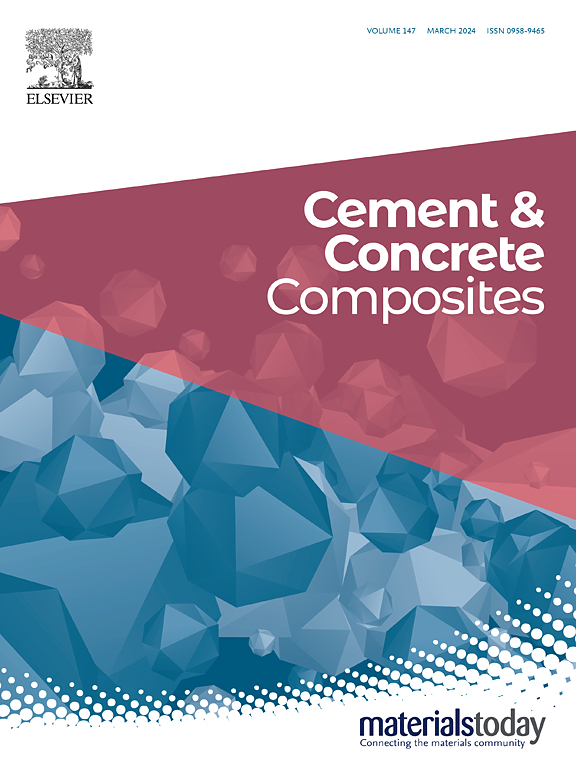从微观和宏观角度对水泥悬浮液渗透阈值的物理含义进行了新的认识
IF 13.1
1区 工程技术
Q1 CONSTRUCTION & BUILDING TECHNOLOGY
引用次数: 0
摘要
渗透阈值对水泥基材料的屈服应力有重要影响。然而,由于缺乏稳健可靠的实验方法和计算模型,这一关键参数尚未得到很好的理解。本文通过屈服应力的回归分析估算了渗流阈值,并从微观和宏观两方面揭示了渗流阈值的物理意义。结果表明,回归方法不能捕获理论渗透阈值,而是刚性渗透阈值。刚性渗透阈值反映了机械稳定相互作用网络的形成,由胶体力和主要分离力(重力或布朗力)之间的平衡决定。在重力大于布朗运动的水泥浆体中,刚性渗透阈值明显高于理论渗透阈值。在刚性和理论渗透阈值之间建立了幂律关系,其中指数依赖于引力psamclet数。在含有大量细颗粒的浆料中,布朗运动超过重力,刚性渗透阈值与理论渗透阈值一致。从宏观上看,刚性渗透阈值与水泥浆体的出血直接相关。当固相体积分数低于刚性渗透阈值时,由于不足的水泥颗粒无法形成内部颗粒网络来抵抗重力,可能会导致出血。本文章由计算机程序翻译,如有差异,请以英文原文为准。
A novel insight into the physical implication of percolation threshold of cement suspensions from microscopic and macroscopic perspectives
The percolation threshold plays a significant role in influencing the yield stress of cement-based materials. However, this crucial parameter has not been well understood given the absence of robust and reliable experimental methods and computing models. This study estimates the percolation threshold through regression analysis of yield stress and reveals its physical implications from the microscopic and macroscopic perspectives. The results indicate that the regression approach does not capture the theoretical percolation threshold, but rather a rigidity percolation threshold. The rigidity percolation threshold, reflecting the formation of a mechanically stable interaction network, is governed by the balance between colloidal forces and dominant separating force, either gravity or Brownian force. In cement pastes where gravity dominates over Brownian motion, the rigidity percolation threshold is significantly higher than the theoretical percolation threshold. A power-law relationship has been established between rigidity and theoretical percolation thresholds where the exponent is dependent on the gravitational Péclet number. In pastes containing large amounts of finer particles, where Brownian motion exceeds gravity, the rigidity percolation threshold aligns with the theoretical percolation threshold. From a macroscopic perspective, the rigidity percolation threshold is directly linked to the bleeding of cement pastes. A reduction in the solid volume fraction below the rigidity percolation threshold can result in bleeding, since the insufficient cement grains cannot form an internal particle network to resist gravity.
求助全文
通过发布文献求助,成功后即可免费获取论文全文。
去求助
来源期刊

Cement & concrete composites
工程技术-材料科学:复合
CiteScore
18.70
自引率
11.40%
发文量
459
审稿时长
65 days
期刊介绍:
Cement & concrete composites focuses on advancements in cement-concrete composite technology and the production, use, and performance of cement-based construction materials. It covers a wide range of materials, including fiber-reinforced composites, polymer composites, ferrocement, and those incorporating special aggregates or waste materials. Major themes include microstructure, material properties, testing, durability, mechanics, modeling, design, fabrication, and practical applications. The journal welcomes papers on structural behavior, field studies, repair and maintenance, serviceability, and sustainability. It aims to enhance understanding, provide a platform for unconventional materials, promote low-cost energy-saving materials, and bridge the gap between materials science, engineering, and construction. Special issues on emerging topics are also published to encourage collaboration between materials scientists, engineers, designers, and fabricators.
 求助内容:
求助内容: 应助结果提醒方式:
应助结果提醒方式:


